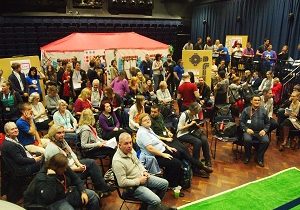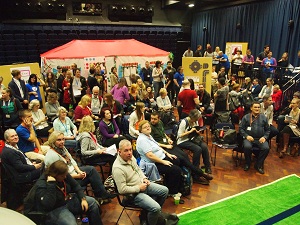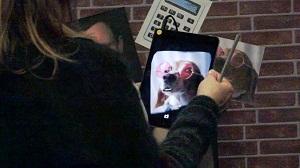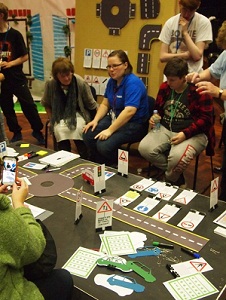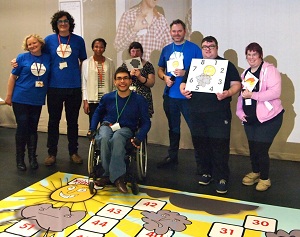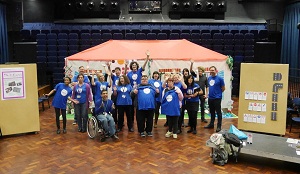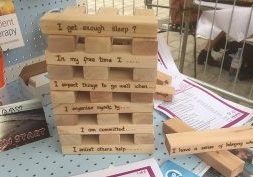Boingboing blogs from… Designing Resilience
The Designing Resilience Showcase Event – 6th November 2015, Brighton
by Ceri Davies – Development Manager, Community University Partnership Programme, University of Brighton
Q: What do you get when you put academics, designers, young people, practitioners, students, trainers, parents, digital geniuses, cups of tea and biscuits all in one room?
A: Read on!!
Previous blogs already offer some of the background and hard work undertaken by this diverse range of people building up to what I am going to write about… But I will offer the briefest of re-caps of the Designing Resilience project… The idea behind getting all these people together was to try to combine thinking that some of us had done on academic ‘resilience’ and ways of designing, making and creating that some of us were quite expert in to see if this could bring the these ideas further to life. We know that different types of people like to use the framework, and so we wanted to explore some of the different ways to do this.
On Friday 6th November, the fruits of all that labour were on display in a big and busy Designing Resilience Showcase Event held at the University of Brighton. We had a lovely lot of interaction on our Twitter.
Angie (academic resilience) opened the event with Nick (design academic), Camilla (design student) and Laura (community art group participant). They each spoke briefly about what they had done and what they hoped to achieve from the day. They explained that they had enjoyed working together to develop the tools and games that were on show today. We also heard that some of the participants had learning difficulties and this had been an exciting process where – through the Sun and Clouds game they had seen their ideas come to life. Nick emphasised that what was on display for people to explore were our ‘prototypes’ – the first draft if you like of collaboratively designing these tools, which each had a theme. There were 10 themes in all, and by way of introduction the people who had ‘specialised’ in one of the themes to tell us more about them. We went around the room in this way and heard about everything from a ‘resilience roadmap’ to the ‘resilience tower’… We were then all released to explore!
I went to check out The Graffiti Wall and The Road Map first. The wall is visually laid out in a similar way to the resilience framework – what makes it really interesting, is that it contains embedded videos that use augmented reality… What this means is that there are faces/pictures/signs stuck on the wall and if you hold your phone/tablet over them (with the right kit) the images come to life and say something about key resilience moves they may have made. This was a great way to give voice to people in a safe way, and meant they could express their feelings through characters.
Next, The Road Map which was a huge hit! I had to peer through the crowds… This had been worked on intensively with practitioners and young people from HeadStart in Blackpool. The idea here is that resilience itself is a journey and the creators used lots of analogies from road signs to offer information and points to consider as you go along – it came with an accompanying highway code (brilliant!) to help interpret and use these signs. What was also interesting about this is that the interpretations for these road signs had built cumulatively – so it could both collect interpretations of resilience, as well as be used as a learning tool.
I also dropped in to the Resilience House – from which I have fond memories of our trip to Cardiff last year. The house was looking fab as ever, and different spaces inside represented different elements of the framework. In the kitchen, I also found out a bit more about a toolkit resource that has been developed by Angie Hart and Lisa Williams to support schools who are stepping up to support young people – it’s called the Academic Resilience Approach. a free to download suite of information and resources.
Over lunch I reflected on the buzz of the morning and the various conversations I’d had with people. My impression was that these tools really sparked people’s imagination, and could offer them tangible ways to think about using resilience in practice. I had conversations with community centre managers, youth workers and school teachers who were all thinking of ways to incorporate some of what they had seen.
After lunch I tried my hand at the Suns & Clouds game developed by young people with learning difficulties in their art group, Arts Connect, also in collaboration with a fine art student, Connel. Suns & Clouds is a huge floor game – with inspiration taken from snakes and ladders – where you spin a wheel, moved forward and if you land on a sun –identify a resilient move – something you choose to do to make a situation different or better. In contrast, if you got a cloud, you had to identify something difficult, or hard that you faced. It was tricky admitting something negative in public – and I decided to fess up about how sad I had felt when my hamster recently died. Together we agreed that was a sad thing and we all came up with suggestions about how resilience ideas might have helped me.
We then moved into the afternoon slot and I went to check out a variety of trees – 3D, virtual and a travelling tree . These trees could all be visual interpretations of the resilience framework – where you could add leaves, or develop new branches – the metaphor worked well for ‘growing’ your resilience and seeing how others thought about it too. The virtual tree could also be easily shared digitally – so that it could be a resource for others.
And then our time was running out… I want to end by acknowledging all the creative and meaningful things that people had produced. Angie reminded everyone that the tools shown today had all been co-designed which was very labour intensive. A lot of people had worked really hard. We got lots of good feedback about what people had enjoyed and that the process of working with design thinking and resilience had been so impactful. The discussion also covered that lots of existing materials could be ‘re-purposed’ with resilience ideas in mind.
And so to the end… we had a brief discussion about what next and for the future – an online game for people with special needs, a shop so people could buy some of these tools and games, and an acknowledgement of the people and networks we have that are such assets to our work.
Big thank you’s were shared with the Designing Resilience team – and then we had to take it all down!
